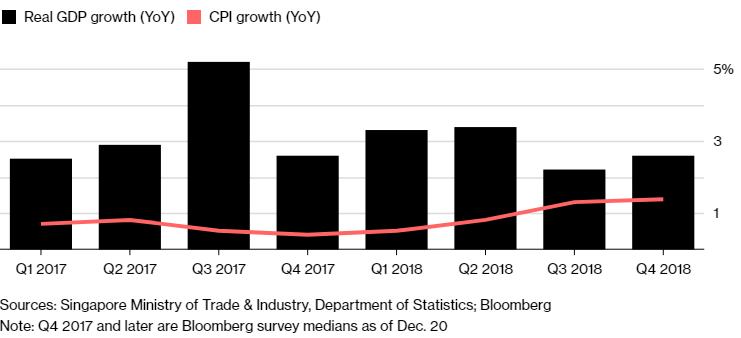Higher Taxes And Rate Hikes? What’s Ahead for Singapore
Singapore is bracing for possible tax increases and monetary policy tightening in 2018 against a backdrop of steady economic growth and benign inflation.
The city state’s economy will probably expand 2.8 percent next year compared with an estimated 3.3 percent this year, while inflation is forecast to pick up slowly, according to the median estimates in a Bloomberg survey. Gross domestic product probably rose an annualized 2.1 percent in the fourth quarter of 2017 from the previous three months, according to a separate survey ahead of data due 2 January 2018.
Smooth Sailing
Economists see Singapore set for steady growth, calm inflation in 2018.
While some economists including Selena Ling at Oversea-Chinese Banking Corporation (OCBC) say the potential domestic fiscal and monetary policy tightening may pose headwinds to the Singapore economy, they still see a “benign” macroeconomic environment with domestic growth drivers having broadened beyond manufacturing and electronics.
“Global growth is picking up and broadening and there is still some decent ongoing momentum,” supporting the view that the export push from 2017 will persist into next year, said Khoon Goh, head of Asia research at Australia and New Zealand Banking Group in Singapore, who is forecasting economic growth of 4 percent in 2018. “We had several years of pretty sub-par, below-trend growth. It is about time we had a nice recovery.”
Goh’s rosier forecast includes a bet that trade-reliant industries that cut jobs over the past few years will start to hire again, benefiting consumption, and that recent gains in construction will pick up pace.
No Longer Neutral
That recovery may spur the central bank to move away from its neutral policy stance. The Monetary Authority of Singapore is forecasting growth of 1.5 percent to 3.5 percent in 2018, with its core measure of inflation seen fairly stable at an average of 1 percent to 2 percent.
The MAS, which uses the currency as its main policy tool rather than interest rates, opened the door to a tightening move at its last policy meeting in October. Economists such as Goh and Mohamed Faiz Nagutha at Bank of America Merrill Lynch see an adjustment in October, while Maybank Kim Eng Research’s Chua Hak Bin predicts it will come as early as April.
The budget, which is likely to be announced in February 2018, will be closely watched with the government already signaling it may raise taxes. While speculation has centered around an increase in the goods and services tax (GST), authorities have a range of options such as raising the stamp duty or motor vehicle levy, said Ling, head of treasury research and strategy at OCBC in Singapore.
“There is no smoke without fire,” she said. “They’ve hinted quite strongly that there’s some tax changes coming up, probably they will announce something in the budget.”
Corporate and income taxes, which together make up almost half of the government’s tax revenue, probably won’t be adjusted since that would hinder competitiveness and would be counter to moves in the US which cut taxes.
Taxman’s Haul
GST, company levies rack up most of the government’s yearly intake in Singapore.
Trade will remain a top long-term priority as Singapore helps shape the regional agenda as chair of the Association of Southeast Asian Nations in 2018. That should mean more talk about boosting intra-regional trade that has languished over the past decade, according to Nomura Holdings Inc.
“We see plenty of scope for ASEAN to reap the benefits from increased intra-regional trade,” Nomura analysts said in a note. “With growth this strong, demand for exports from within should naturally pick up.”

 Yahoo Finance
Yahoo Finance 


